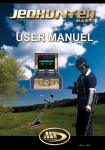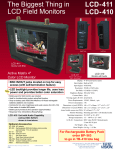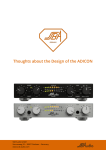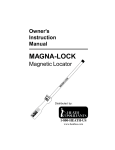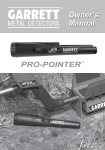Download English Jeotech User Manual
Transcript
CONTENTS Accessories and Components ............................................. 3 System Unit and Joystick ..................................................... 4 Assembly and Charging the Battery ................................... 6 Jeotech Using Phases .......................................................... 9 What is ground setting and how it is done? ...................... 11 Steps for the Ground Setting ............................................. 12 Performing Search ............................................................. 15 Technical Details ................................................................ 16 Accessories ........................................................................ 17 1 WARNING! PLEASE DO NOT START ASSEMBLING OR USING BEFORE READING THE THIS SECTION! 1. SINCE THE DEVICE IS ELECTRONIC AND VERY SENSITIVE; NEVER ASSEMBLE AND OPERATE BEFORE READING THE USER MANUAL. 2. DO NOT START SEARCHING BEFORE MAKING GROUND SETTINGS. IT WILL NOT BE POSSIBLE THAT THE DEVICE OPERATE CORRECTLY UNLESS THE GROUND SETUP IS MADE. 3. DO NOT USE ANY OTHER DETECTOR OR A DEVICE THAT EMIT MAGNETIC WAVES WITHIN 10 m PROXIMITY OF THE DEVICE. 4. PREVENT THE DEVICE FROM ABRUPT MOVEMENTS AND POSSIBLE SHOCK. 5. DO NOT EXPOSE THE DETECTOR HEAD TO DIRECT HEAT; DO NOT EXERT FORCE DURING ASSEMBLY AND USE. 6. THE BATTERY SHOULD BE DECENTLY PLACED IN ITS CASING AND CARE SHOULD BE TAKEN “+” “-“ POLES ARE NOT CONNECTED BY A METAL PIECES. 7. DO NOT EXPOSE THE BATTERY TO HEAT. 8. CHARGE THE BATTERY IN ROOM TEMPERATURE. 2 ACCESSORIES AND COMPONENTS 1. Electronic System Unit and Joystick : It is the part where the detector sockets, headphone socket and battery socket are located and where measurement results are evaluated and displayed on the LED monitor on joystick. 2. 210x315 mm Search Coil: It is the antenna that the detector gets the signal from the ground. 3. Batteries 11.1 V, 2 Ampere Lithium Polymer rechargeable batteries. Battery Life: 10 hours 4. Battery Charger: It is a device to charge 11.1 V 2 Ampere Lithium Polymer batteries. Input: AC 100-240 V / 50-60 Hz / 1A (City mains) Output: DC 9– 12 V / 400 mA Charge duration: 10 hours 5. Carrying Case It is a case used for transport and storing of the System Unit, the 210x315 mm Search coil and accessories. 6. Headphone: It is the piece that maintains vocal communication between the detector and the operator. Waterproof speaker on the electronic system is turned off when using the headphone to enable only the operator to hear the sound of the detector. 3 SYSTEM UNIT AND JOYSTICK SYSTEM UNIT AND BUTTONS 1- ON/OFF SWITCH: The switch that is used for turning on or turning off the device. 2- GROUND SWITCH: The switch that is used for ground setting. 3- SENSITIVITY: The switch that is used for adjusting the sensitivity level. 4- SOUND AND LIGHT ADJUSTING SWITCH: The switch that is used for adjusting sound and light level. 4 JOYSTICK 1. CAVITY and MINERAL: If there is a cavity effect on the device, the “CAVITY and MINERAL” lights of the device will be on. 2. POWER LIGHT: The light shows that the device is on. 3. METAL and MINERAL: If there is a metal effect on the device, the “METAL and MINERAL” lights of the device will be on. 4. SCAN: A key that enables analyzing a target when pressed passing over it. 5. FERROUS LIGHT: The light shows that the target is a ferrous metal. 6. BATTERY LEVEL LIGHT: The light shows the level of battery. 7. NON-FERROUS LIGHT: The light shows that the target is a non-ferrous metal. 8. RESET: Resets all detector settings (Default Settings) in reference to recent settings whenever resetting is done. 5 ASSEMBLY AND CHARGING THE BATTERIES ASSEMBLY Search coil is taken off the carrying case and telescopic extension tube is inserted, piece Nr.1 into piece Nr.2 as shown in the diagram and tighten the sleeve. The Search coil is dismounted from the extension tube when packing in the carrying case. Dismantling is carried out as the reverse of the process described above. CAUTION: Do not take apart the screws that connect the Connecting piece and Search coil. Take off only the telescopic tube without damaging cable coil and suitably store in the carrying case. 6 SEARCH COİL CONNECTION Transmits the data received from Search coil to the Electronic system box. The 5 pin plugs shown in the above figure are connected to socket on the system box. HEADPHONE CONNECTION Enables signal sound to be switched from external loudspeaker to the headphone. The plug shown in the above figure is connected to socket on the system unit. 7 BATTERY CONNECTION Plug the battery to the socket on the system unit as shown below. 2. CHARGING THE BATTERIES Connect the charger to the battery. When battery is being charged red LED will lights and when the charging is done green LED will lights. If there is no battery attached to the charger or the attached battery is fully charged the green LED lights. After charging, disconnect the charger from the battery. The charging period required for a fully depleted battery to be fully charged is 7 hours. 8 USING PHASES Turning On the Device: The "ON/OFF" button on the device is activated in order to turn on the device. Checking Battery Status: Look at the battery charge indicator on the device. If three lights are on, it means that the battery is fully charged. If two lights are on it means that the battery is half full, if a single light is on it means that the battery charge is low. If there lights are periodically blinking, it means that the battery power is insufficient to operate the device. If no lights are on it means that the battery is depleted. In case the battery is depleted or on low charge turn off the device and charge the battery by connecting to the charger. FULL HALF LOW EMPTY Use of the Light Button: The "LIGHT" button is used to set the light level of the device. The device is designed as appropriate for use during day and night. By this button, the light may be turned on to the brightest level and it may be ensured that the light is seen even under the sun. At the same time, the light may be turned off to the full extent when one does not want to see the light. For light settings, the light button is set to a preference between levels "Min" and "Max" after the device is turned on and the light level is set. NOTE: When battery is flat, all three “BATTERY” lights flash and a sound alarm is generated. NOTE: When search coil breaks down or when the search coil is not detected, “VALUABLE” and “INVALUABLE” lights will flash to warn the operator. 9 Use of Sound Button: The "SOUND" button is used in order to set the sound level of the device. In order to be able to make the sound setting, the light level is set by making a preference between the levels “Min” and “Max” after the device is turned on. When the device is connected to a headphone, the speaker will be deactivated and the sound will inform the operator through headphone. Use of Reset Button: When using the device, there may be some interference due to moving the search coil in an unbalanced manner and the environment. Such interferences cause the device to turn on the screen lights and generate a sound alert. Reset terminates the effect of these interferences. The reset takes place by pressing the button below the handle of the device. Reset should not be made when the search button is on the target! This causes loss of depth, assessment of the received signal in a mistaken manner and makes the device unable to detect the target. Reset takes place after the search coil is taken to a side off the target. Don't forget to reset after every action you take! (Do not reset on the target.) Using the SCAN Button: When target is detected during search, the device is moved off the target and the "SCAN" button is pushed again and the device is moved over the target once more; the target is analyzed in the meanwhile. If the "VALUABLE" light is on when passing over the target, then the target is valuable and if the "INVALUABLE" light is on, then the target is invaluable. Sensitivity Setting: After turning on the device, “SENSITIVITY” button may be used for Sensitivity button. Sensitivity setting takes place between “Min 1” and “Min2” and “Max”. 10 Sensitivity consists of 3 steps: Max: The sensitivity step where the depth of the device is maximum. When the device is used with this step, it can easily detect even small objects from a deep distance. As this step provides the device with excessive sensitivity and power; the device will be increasingly affected from the earth and will become more difficult to use. Therefore, the ground setting should be made in the best manner possible. When the sensitivity setting is set to “Max”, the ground setting must be done again. Between Min 2 - Max: It has a high perception capacity. It is preferred for types of ground, for which “Max” step cannot be used. It has perception depth that is lower than “Max” but it is less affected by the structure of soil as compared to the "Max” step. And when it is turned from Min2 towards Max level, sensitivity level will continue to rise. Min 1: The lowest level of sensitivity. At this level, the device is least affected from the soil. Soil setting may be made easily but at this level, the device may have difficulties in detecting small objects. This should be used to detect the large metals or large holes. WHAT IS GROUND SETTING AND HOW IT IS DONE? In our country land formation and soil composition vary in relation to regions. In some regions the composition may vary frequently (Sand, lime, red earth with dense mineral content, rocky formation, etc.). These variations in soil composition mislead the detector and cause perception as metal or void. Therefore first we have to launch the soil characteristics of the region to the detector’s system. Launching these data will block all misleading effects that may come up from the ground; these will be perceived as misleading signals from the ground, and thus eliminated. Ground setting is one of the most important provisions of exploration. Therefore the operator should be a keen observer and should be able to detect variations in the ground. He has to observe soil compositions continuously to be able to make ground adjustment again in case misleading signals the device will perceive results from variations in soil composition. Ground setting is made for the device to recognize the soil and not to be affected by it. Thus the device is not affected from metal or void reflections of varying soil compositions. If ground setting is not properly done it will cause loss of depth and minerals to be evaluated as metals or voids. Therefore ground settings should be made as correctly as possible. Considering the general condition of land formation in our country, a ground setting system is established that will eliminate ground effect on the device. 11 STEPS FOR THE GROUND SETTING 1. Turn on the device. 2. The Ground Setting should be made at a spot where one is sure that there is no metal and cavity. If the ground setting cannot be made accurately, it is moved to the side and an attempt is made to make the setting again. 3. The operator raises the search coil of the device by “40 cm.” and approaches the search coil to the ground by "3-5 cm" parallel to the soil after reset. 4. If there is no ground effect on the device, none of the “Cavity and Mineral” and “Metal and Mineral” lights will be on. And this means that the device is suitable for a search on that ground. 5. If there is a ground effect on the device, the “METAL and MINERAL” or “CAVITY and MINERAL” lights of the device will be on. 6. In case of a warning for “METAL and MINERAL”: a. Raise the search coil of the device by 40 cm from the ground and hold it parallel to the ground. Press the (+) button a few times. Then have a reset immediately. 12 b. Lower the search coil back to 3-5 cm. distance parallel to the ground again. c. If the effect on device is eliminated as a result of such procedures, none of the “Metal and Mineral” lights will be on (“Cavity and Mineral” lights shouldn't be on, either.) This will mean that the device is suitable to make a search on that ground. d. If the ground effect continues, the device will continue to turn on “Metal and Mineral” lights and to generate sound alerts. e. In such a case, raise the search coil to a distance of 40 cm. Press the ground button a few times in “+” direction and reset. Take the search coil close to the ground by the same distances again. If the lights are on and the sound alert continues (and the number of lights on will be reduced after every action) these procedures should be continued until the effect is lost. 7. In case of an alert for “CAVITY and MINERAL”: a. Raise the search coil to 40 cm above the ground and hold it parallel to the ground. Press the button in “- “ direction. Then reset immediately. b. Move the search coil to a distance of 3-5 cm. to the ground in a position parallel to the ground. c. If the ground effect on the device is eliminated as a result of such actions, none of the “Cavity and Mineral” lights will be on (“Metal and Mineral” lights shouldn't be on either.) This will mean that the device is suitable to perform a search on such ground. d. If the ground effect continues, the device will continue to keep the “Cavity and Mineral” lights on and to generate a sound alert. 13 e. In such a case, raise the search coil to a distance of 40 cm again. Press the “ - “ button a few times and leave after reset. Approach the search coil to the ground by the same distances again. If the lights are on and if the sound alert continues (and the number of the lights on will reduce after every action) these actions should be continued until the effect is lost. 8. If the ground setting cannot be done as a result of the actions explained above, the "SENSITIVITY" level of the device should be reduced and the actions explained above should be repeated. NOTE: If you are having difficulties in making ground setting on tough ground (with intense mineral content) and if the soil setting cannot be provided accurately; it is also possible to perform a search with a single light on the “Metal and Mineral” or “Cavity and Mineral” side. NOTE: As the sensitivity levels are reduced, there is a decline in sensitivity in detecting metals. NOTE: The search must be conducted in the part, for which the sensitivity of the ground setting is adjusted. NOTE: While using the device, when you encounter a surface that has a different structure than the one you made the ground setting for, the device starts to keep generating cavity and metal signals. When you start to receive signals from the device all the time, the ground setting of the device should be made again. 14 PERFORMING SEARCH The search coil is raised by 40 cm from the ground and reset is performed. Keep the search coil 8-15 cm from the ground and parallel to the ground. You can conduct search by slow motions, making the device move to the right and to the left like you're sweeping the floor or by walking straight. Try to detect a target by conducting search in this way. The device will generate a sound alert when it detects a metal and the lights "METAL AND MINERAL" will be on depending on the signal strength. When the device detects cavity, the "CAVITY AND MINERAL" lights on the screen will be on depending on the signal strength and a sound alert will be generated. If our target is metal or cavity, then the device generates sound and light alerts. When a warning is received from the device when the device is on a spot, the device is removed away from the target and reset is performed at a spot with no signals and the search coil is passed on the same target again. If “CAVITY and MINERAL” lights are on, our target is a cavity. “METAL and MINERAL” lights are on, our target is a metal. The search coil is passed over the same target again after repeated resets if necessary. This final action is taken to be sure of the target. While performing a search with the device, move to the side away from the target when you receive a metal signal and move over the target again after pressing the “SCAN” button; in this case, if the metal is a valuable metal, “NONFERROUS” light will be on and if it's a junk metal , "FERROUS" light will be on. 15 TECHNICAL DETAILS Target Diameter (cm) Depth (cm) 5 Turkish piaster (16.50 mm) 23 cm 25 Turkish piaster (20.50 mm) 27 cm 1 Turkish Lira (26.15 mm) 33 cm 5cm x 5cm 50 cm 20cm x 20cm 95 cm 40cm x 40cm 120 cm 60cm x 60cm 155 cm The values stated above aren’t generated values; they are gathered by trying new metals. As the dimensions of the metals increase, there is an increase in the depth as seen in the ratios stated in the table. If metals remain under the ground for a long time, in pace of that time they establish a magnetic area and these magnetic areas radiates as if there are transmitters. By this means, the receiver of the research antenna ensures detection of the same target in 3-4 times deeper areas. Dimensions 210 x 315 mm Coil weight 990 gr Total weight 2.317 gr Frequency 12,5 KhZ Radio Frequency System VLF (Very Low Frequency) Used mode LED (Light-Emitting Diode) 16 ACCESSORIES Condura Plastic totebag for the whole hardware. Headphones Battery carriage leather shift Headphones (Optional) Automotive charger (Optional) Lithium Battery Polymer Universal AC charger 100 - 240 Volt, 50 and 60 Hz Battery Operating voltage Battery current Charger Input Output 11.1 V 3.3 A Rechargeable Lithium Polymer Battery 10 V – 12.6 V 3.3 A 12.6 V, 500 mA Lithium Polymer Battery Charger AC 100-240 v / 50-60 Hz / 180 mA (city mains) DC 12.6 V / 500 mA Warranty Period: 2 years Note: Battery, bags, headphones and chargers are not covered by warranty. 17




















